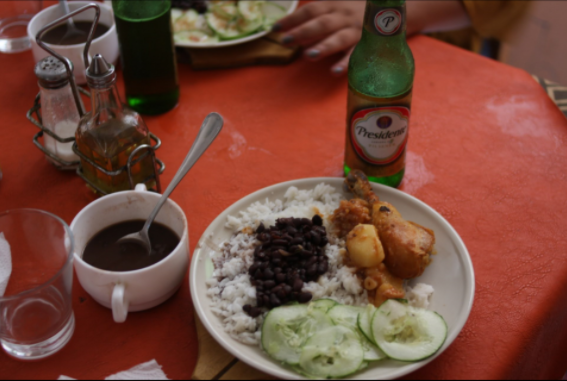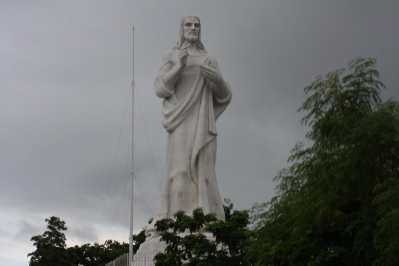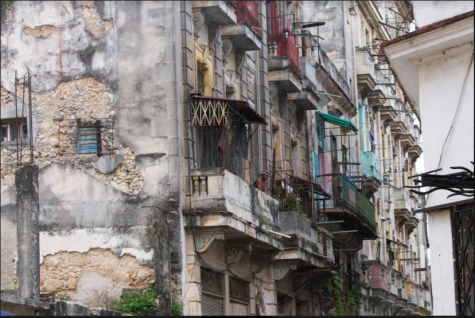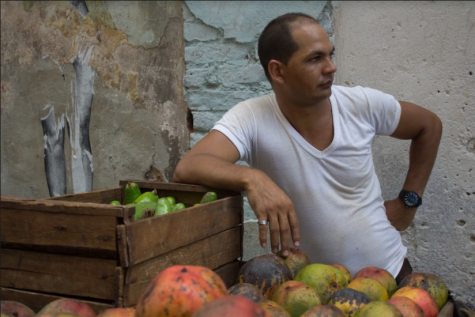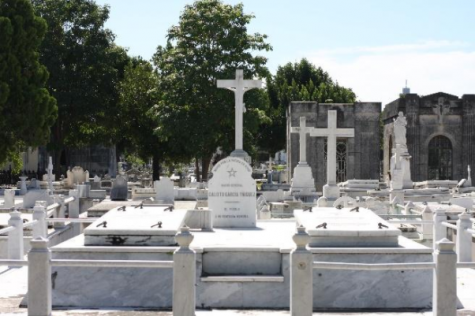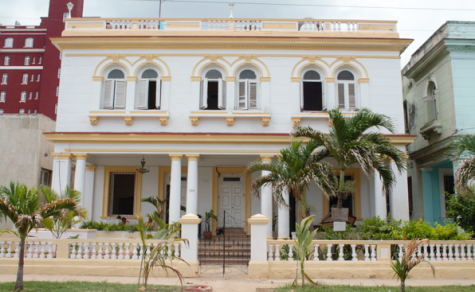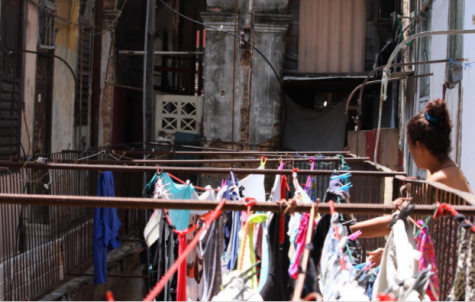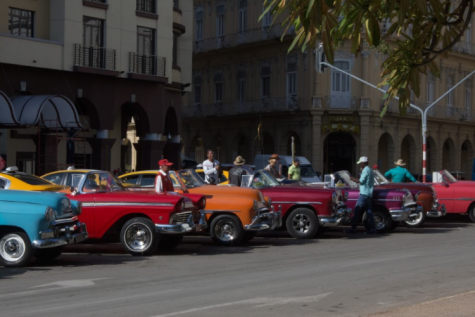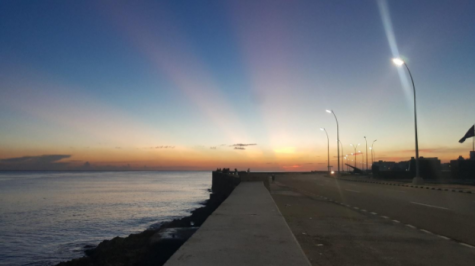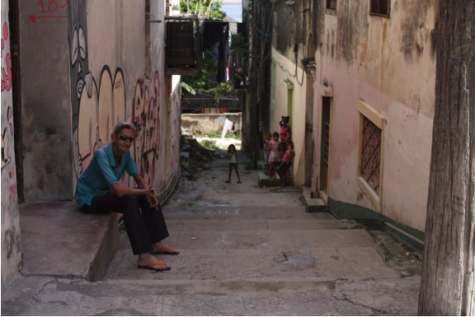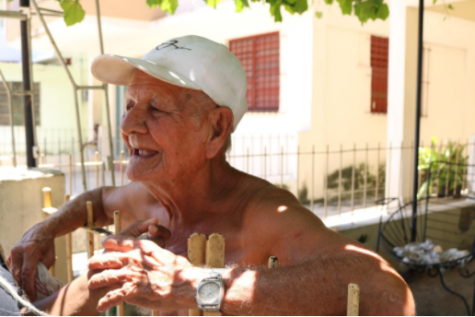Adam Murphy
August 23, 2017
“No fotos por favor”
Today was my third full day in Cuba, but my first as a photojournalist. Unlike other students on my trip to Cuba, I am not proficient in taking pictures on a professional camera. To make up for this our professor gave us a crash course class in about an hour. After which we were directed to practice taking pictures, then report back to her a couple hours later. Hmmm… where to go? What to shoot? The storm clouds were rolling into Havana like some biblical storm was approaching. In the distance, I could hear the thunder and see the lightning rock and flash across the afternoon sky. This put the pressure on me to get some shots done before the rain restricted me from taking pictures outside. Ah…I got it!! The perfect place to take pictures was less than half a block down the street. I noticed it when I first got to the hotel. It was a run down soccer field surrounded by a track and a large amphitheater for people to watch the games. Over my first few days in Havana, I regularly saw many people play soccer there and exercise. Since my project is about exercise and nutrition I figured what better place to go for my first shots.
In total, about five of us went there to take pictures for various reasons. Our large group of fair skinned people with cameras around our necks drew a lot of attention. As we walked down the street it seemed like every single car honked at us to ask if we needed a taxi. Beep beep… Taxi? They would ask. Our response started as a “no gracias,” and then changed to us simply ignoring the cars. Upon arrival to the field, our large group split up since people wanted to take pictures of different things. These items included different things such as the field, stadium, workout equipment, etc. Unlike other members of my group, I came there to get pictures of people exercising either on the jungle gym, the soccer field, and the track that surrounds it. This day was a Monday afternoon, because of that nobody was on the field doing any exercise related activities. So I simply walked around getting shots of the exercise equipment and the old stadium. After a few shots, I began exploring the area behind this stadium where I was surprised to discover other exercise related areas such as a badminton court, three full sized basketball courts, and three gigantic Olympic sized pools.
After taking many pictures a man appeared and told us, “no fotos por favor.” He began to follow us around like a fly hovering around garbage. Convinced he was a shady character looking for money we all put our cameras away and left that area. Luckily the man did not follow us. Our group moved to a new area that was connected to this large sporting location. After about thirty seconds of taking shots there, the same shady looking man appeared and told us, “no fotos” in a stern voice and waved his hands in displease. Luckily this time one of the people within the group knew Spanish and begun talking to him and found of he was the director of this large sporting complex. He told her that he did not want people to take pictures because he was afraid that we would use the pictures to show the poor condition of Cuba recreation facilities to others back home. It was quite the opposite, however. Everybody in the group was amazed at how beautiful the structures were and how they have survived for many years. After talking for a few minutes he agreed to let us walk around, but not take pictures.
This taught me a couple valuable lessons related to Cuba. The first is that pretty much any place you go people will be there sitting in a chair watching for pictures and to make sure nobody messes up the items at the place whether it be at this sporting complex or a museum. The last lesson it taught me was not to assume every Cuba approaching you while you are taking pictures will because they ask for money. A lot of times they just want to spark that conversation. It is up to you ask questions to understand the situation and learn about the person’s story. Distrust is easy when there is a cultural and language barrier, but understanding and communicating is hard. Doing so, however, will enrich your experience in the foreign country and allow you to grow as a person. So next time someone tells you, “no fotos por favor,” ask why? The answer and following conversation might surprise you.
Backyard fitness
Before I came to Cuba, all of my research online showed that there was very little here in terms of the exercise and nutrition culture that we have back home in the states, but after only a couple days here I have been proven wrong.
It started on the ride to the hotel from the airport. At first, it was the Cuba of the movies, which is palm trees, run down houses, bright colors, and old American cars, but then evidence of exercise begun to appear. It started with the sighting of a huge sporting complex that looks like where Olympic athletes for Cuba train. Then at a stoplight, I was looking out the window and noticed two people doing squats and lunges while a personal trainer was watching them. Eureka! The first real sign that there is a “fitness” culture here in Cuba.
Right before our taxi arrives at the hotel I notice a relatively big sporting complex that is run down. It contains a soccer field surrounded by a dirt track, a large amphitheater with seats a jungle gym. On the field, boys were playing soccer. People ran around the field on the track doing laps and other folks were on the jungle gym doing pull-ups, push-ups, and dips. More signs of a fitness culture here in Cuba.
A few days later after walking back to the hotel from lunch, I hit the jackpot. I look at a small sign outside a house that read, “Horario Gym, Lunes a Viernes, 7:30 AM-12 M, 3:00 PM-9:00 PM.” Although I do not speak Spanish, I understood that this sign read that this place was a gym and these were the hours and days it was open. Unfortunately, it was closed during that time since it was 1:30 p.m., but I finally got a good lead on fitness culture.
Eventually I came back the next evening where I found a small backyard gym that was packed with 10 to 20 people. All the machines did not look new or top-of-the-line, but all machines worked and performed similar functions to work out equipment back home.
As soon as you walk in you are in the heart of the gym. Bench press, squatting area, hack squat machine, and various other cable-based machines litter the area. Behind that within the house is a small free weight area where people were working out with dumbbells. Behind that was an even smaller area that had a workout bike and some mats for people to do abdominal exercises.
As soon as my group and I walk in with cameras around our neck, all the eyes of the people within the gym are on us. Within the crowd of people, a man appears to be a person that works there. After talking to him with the help of a girl from my group who translated, I found out that his name was Alejandro and he was the owner of the gym.
He started the gym four years ago in the area in front of his house. One side was the entrance to the gym while the other side was the entrance to his house. He explained the government taxed his gym and that anybody could come, but they had to pay to use it. The cost to go to his gym was one CUC a day. All the equipment within his gym is homemade or custom ordered, which was shocking because it had all the basic equipment you would see at a gym back in the United States.
We talked for a while about various things related to fitness specifically the prevalence of gyms in Havana and where we could find them. He ended up giving me the addresses of the four closest gyms in Havana. After that, I asked him about nutrition specifically supplements, as this is a popular topic related to fitness back in the US. He explained to me that it is very hard to get supplements in Cuba as they are very expensive, but he said some people do get them on the black market from various countries like Mexico, Europe, and even the United States. A few seconds after telling me this he brings back a big tub of whey protein supplements. The writing was in Spanish and he said it was from Mexico, but it was a US brand that makes exercise supplements.
After exploring for a bit and talking to him, I tell him I’ll return in a few days to exercise and bug him with some more questions. This small and what some would call primitive gym was amazing because it had many of the same functional machines and equipment as gyms in the US, but it was built with a fraction of the money and equipment. This gym was made due to the passion and ingenuity of Alejandro. I look forward to returning so that I can try the machines and learn more information from the people there about Cuba fitness culture.
Cuba, the land of friendly people
Even since I arrived in Cuba I have been surprised by the amazing hospitality and genuine friendliness of the Cuban people. Everyone wants to talk to you and tell you their story. I have met countless people who want to interact with foreigners specifically people from the United States of America.
I have noticed that Americans are genuinely suspicious of friendly strangers, but here in Cuba, it is common for Cubans to be friendly to strangers. Friendliness is the Cuba way and something Americans can do a better job of emulating. In my short time in this country I have met many friendly people that I do not have time to mention in this blog, but a few that stand out are Clara, our hotel maid, Yosef, the doorman at a local restaurant I attend, Ole, a personal trainer at a gym, and Kennedy, a friend of Ole’s and a former student of physical education. These people have gone above and beyond to help me during my time in this country.
One of my most enjoyable moments here in Cuba is when an old car broke down and a man was trying to push it to get it started but was having trouble. A group of people and myself began to push the car until it started. The majority of people who pushed the car were Americans and students from CSUEB. After the car started many people on the street began cheering and clapping. This made me feel like we were being good ambassadors of the United States to the Cuban people. This is especially important during a time when our president is trying to disrupt and ruin relations between Cuba and the United States.
On this trip there have been numerous times when I have talked to locals who have said the problem between the U.S. and Cuba is between the governments and not between the people. All the people who I have talked to told me how much they loved the United States and want to visit, but unfortunately, it is practically impossible currently due to financial and political reasons. I was surprised to learn that one man I met I traveled much of the world. He showed me pictures of him and other Cubans around the world who were workers on a cargo ship. He traveled to many places in Europe, the Middle East, and south east Asia. He said the money was alright but mainly did it to see other parts of the world. This urge for seeing and hearing about the rest of the world is another reason why Cubans love interacting with foreigners.
Many Cubans can recognize a foreigner from a mile away and often times start a conversation with you and get excited when they see a camera and want to take a picture (for the most part).
Farmer’s market in Cuba
Anywhere there are people, there must be food to feed them. Cuba is no different, but what is different is how people obtain these foods. Back home in the United States, there are many stores in any one city that sell food that can be taken home to be prepared. These stores include supermarkets like Safeway, Lucky, Target, Chavez, and many local farmer’s markets. Unlike America, Cuba does not have these big chain supermarkets where people can come to buy all their goods at one location. They have many supermarkets and farmer’s markets scattered around the city where people can buy food products. Farmer’s markets in Cuba are open every single day and in the city of Havana, it is relatively easy to find one every few blocks.
Since my arrival in Cuba, I have seen many of these farmer’s market scattered throughout the city and I have wanted to go to one. Today I got my wish and went to one my translator recommended near my hotel called Mercado 9na y F. As I walked up, I noticed a dump truck full to the brim with bananas being delivered to the market. Right next to the truck was a small opening to the farmer’s market. As I walked in, I noticed all the attention and eyes turn to me, the foreign tourist visiting an area most tourists do not visit. I started to walk in and get enveloped in a crowd of people. All the people at the market except me were local Cubans getting fresh produce and meat.
The first thing I noticed when I walked into the market was a large sign that had the prices for all the fruits and vegetables posted in the front for everyone to see. As an assistant manager back home for a farmer’s market, I thought this was an innovative way to inform customers of the prices of the produce and what was available that day. After walking past the price sign, the walkway narrowed. I entered a covered shaded market where people were wandering around, shoulder to shoulder. Before reaching the fruits and vegetables the first vendor was a butcher. It was a small operation with one butcher cutting a piece of what appeared to be pork with some more pieces of meat hanging up behind him. Flies buzzing around the bloody pieces of meat, no gloves on the butcher, and the hot Cuba sun spoiling the meat. My first thought was this would not fly back home in the states and my second thought was I wondered if people ever got sick due to these conditions.
After examining the butcher I walked further down the market examining fruits and vegetables on both sides. Every vendor appeared to have the same exact fruits and vegetables which were potatoes, mangos, beets, carrots, bananas, and bags of rice. The market does not last much longer as it only extended another 20 feet or so after the butcher. After reaching the end, which was less crowded than the entrance, I decided to take my camera out to take a few pictures. I pointed my camera at a bundle of carrots and beets and started to adjust the settings on the camera to get the best picture. Click…..click….click. I started taking pictures.
Two seconds after taking some pictures I felt a hand poke my back very sternly. I turned around and a man is talking to me pointing at the camera in a disapproving manner speaking a language I didn’t completely understand, but due to his body language, I understood his point. I said to him, “no photo?” and pointed at my camera. He shook his head in disapproval. I got the hint and quickly put my camera away as I wanted to keep exploring the market. I looked around for a few more minutes and then head back to the hotel.
Last day in Cuba (A journey to Hostel Loretta)
As the sun rises and shines through the window, I find myself wondering if I slept at all last night or simply stayed awake. Today is my last day in Cuba after two weeks of vacation and work. The time seemed like it would drag on like a hot Cuban day, but it flew by faster than the snap of the photo. The moment is bittersweet. I miss the little things back home like washing clothes, not feeling sticky all day, and quality toilet paper. Ironically these items are all part of the Cuban experience that I have grown to love and appreciate. In less than 24 hours I will be back home in the United States, but a piece of me will forever remain in Cuba at the Presidente Hotel. Here in Havana, Cuba I had the chance to participate in a life-altering experience with 27 other students and many local Cubans who embraced us with open arms.
All night I have been awake thinking about my wonderful time in Cuba and how sad I am to go, but with one more day in Cuba comes one more opportunity to enjoy the little things that make this country so great. The hour is 8 a.m. and my roommate is still sleeping. Knock knock… someone is at the door. It’s Daisy and friends who ask if we want to go to Old Havana one last time to eat at one of our favorite restaurants, “Hostal Loretta.” Without hesitation I tell her, “Hell yeah, but give us a few minutes.”
One hour later we are all walking out of our hotel towards the Malecon to flag down a taxi for one of the last times. Like always, we bargain and try to get a lower price than offered. After a few short exchanges, the driver agrees on 5 CUCs. A few minutes later we arrive in Havana to the hustle and bustle of the most touristy area in the city. With that comes many people approaching us trying to sell us goods and services such as cigars, rum, and good food. “No gracias,” we say to all of them; this is not our first time in Old Havana. After two weeks here we are experienced veterans and know how this area of the city works.
We are on a mission to get our favorite food for the last time. It is a place so hidden that even after many times going there we cannot tell a stranger how to get there. Our best description would involve telling people to go straight down the main street in Old Havana and turning left at the churro stand than right at the next block and following the odor of freshly cooked beans and meats. After a few minutes of walking on the uneven cobblestone streets and almost getting run over by a few rickshaw taxis on the way we finally reach our location. A true hole-in-the-wall restaurant at the bottom of a hostel.
The waiter is sitting outside and recognizes us, “Hola amigos!” He does not even have to give us the menus because he knows what we want, “pollo con arroz y frijoles.” The dish itself is simple yet remarkably flavorful. We each get a plate with one chicken leg on it where the meat literally falls off the bone on to the plate of rice and beans. The white rice taste like plain rice, but the black beans and the juice it is cooked in makes the plate delicious. After I mix all the food together like a pot of stew I take my first bite and get sent to a place that can only be described as taste bud ecstasy. With a forkful of food I chew slowly and savor the flavor because I do not want it to be gone. To wash the food down I drink my beer of choice in Cuba which is called, “Presidente” (no relation to our hotel). A few minutes later I am the first one done with my plate; it is so clean it appears like it just came out of the dish washer. I sip my beer slowly in silence reminiscing about my trip here to Cuba and all the wonderful things I have experienced and done.
On the wall of the restaurant, there is a wall where people sign their names and where they are from. I use a marker the waiter provides and write on the wall in thick black letters, “Adam Murphy, Hayward, CA, USA, 2017.” As I finish, I hope the message on the wall is as permanent as the memories I have of this wonderful country. Lastly, we pay the bill and leave a generous tip. “Hasta Luego amigo,” I tell the waiter. Until we meet again…




